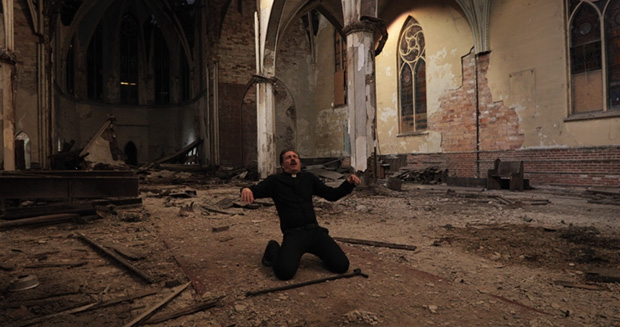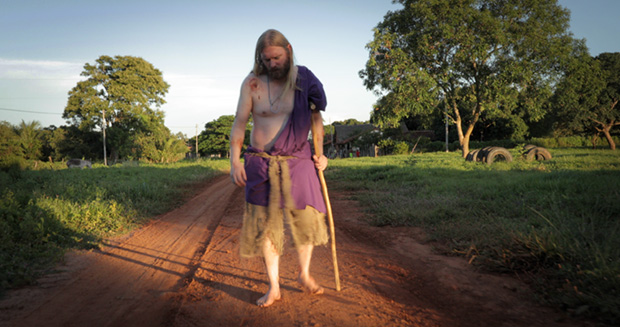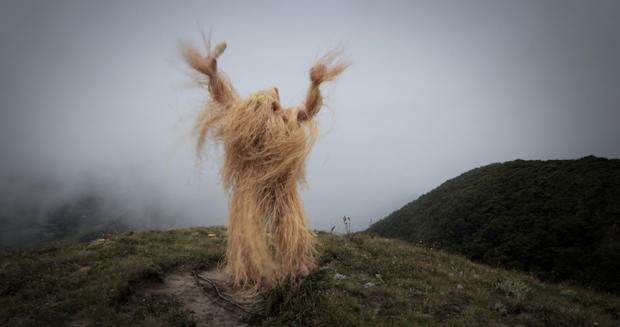Karsten Krejcarek at CEPA Gallery
One thing that jumps out right away—that needs work—about Karsten Krejcarek’s video project currently on show at CEPA is the title: (However) the Owner of the Living (Death) May Pierce (an Abscess) and Spread Ruin, Babalú-Ayé.
Things get better after that—a little clearer and more comprehensible—though still amid plentiful mystery and obscurity. But within a more or less universal religious pilgrimage narrative. Through hell and purgatory, seeking salvation. (Some of the more hellish sequences not suitable viewing material for youngsters or the squeamish.)
Mystery and obscurity owing to the mix of cult elements informing the pilgrimage narrative, based on Santeria beliefs and practices—Santeria is a Caribbean association mix of the West African Yoruba ethnic group religion and Christianity—but no doubt with some auteur-specific twists and wrinkles slotted in.
The video was taped in various exotic Caribbean and South American locations and Buffalo—the opening scene at least, in one of the waterfront old grain silos.

One of three main figures in the narrative is Babalú-Ayé, an orisha—a manifestation of the supreme god—with multiple special offices and powers, who both punishes and purifies, and is both greatly feared and greatly loved by the laity. The Babalú-Ayé figure is costumed entirely in raffia, a dried grass, except with tennis balls for eyes. (He looks like a cross between Big Foot and Big Bird.)
In Santeria, Babalú-Ayé is conflated with San Lázaro. Not the Lazarus Jesus raised from the dead, but the other Lazarus, the leper, who lay outside the rich man’s gate, and the dogs would come and lick his sores, but then when he dies he is received into the bosom of Abraham (while when the rich man dies, his reward is eternal torment in Hades).
The third main character is the protagonist, whose pilgrimage adventure kicks off after he is accidentally stabbed in the chest with a junkie’s used hypodermic needle—this must be symbolic, because hardly realistic, but not clear just what symbolic of—and culminates in his participation in the Procesión de San Lázaro pilgrimage ritual held annually in El Rincón, Cuba. Involving crawling on hands and knees—and for penitential good measure for this pilgrim, with half a concrete block chained to one leg—over a four-kilometer distance to the shrine church of the saint.
Apparently the purgational effort is a success. In a final sequence, the protagonist and the Babalú-Ayé figure—on side by side dual screens—the whole movie is on dual screens—dance contortionistically, until the Babalú-Ayé figure fades, and the protagonist levitates.

In an adjacent space, some props and artifacts from the movie. The Babalú-Ayé raffia costume. The junkie’s spoon and hypodermic needle. Some of the Lázaro figure’s body sores that looked so gruesomely realistic in the movie—silicone stick-ons, it turns out.
In the upstairs passageway, a few dozen still photos, and in the basement gallery some video vignettes, on dual screens again.
Some of the still photos related to the video, but more to the mystery and obscurity aspects than the comprehensible narrative. A pig’s head in a terra cotta bowl. Some shots of an old man, half-naked, in a forest setting. The head of a woman, seen from behind, against the Washington, DC, reflecting pool in the background, entitled Jesse in the District of Columbia on the day I realized life was about to change. A man in a white cassock and over-the-shoulder blue decorative ribbon attending a prostrate figure, apparently after just completing the Procesión de San Lázaro. Boxes of bones—said to be human bones—possibly related to some anthropological study. A dug hole in the ground roughly the diameter of a sewer manhole, entitled Torture Hole.
The video vignettes include some spectacular geological scenes. A pool of boiling lava, a geyser, and what looks like either a rock formation or portion of glacier. And a neat little pyramid of human skulls on a small raft in water, and a girl walking into the water, approaching the raft of skulls. From time to time, snatches of gnomic voiceover.
What they seem to add up to—the still photos and vignettes—scores of untold stories. Some possibly worth telling. We don’t know.
The Karsten Krejcarek exhibit continues through May 21.
(However) the Owner of the Living (Death) May Pierce (an Abscess)
and Spread Ruin, Babalú-Ayé
CEPA / 617 Main St, Buffalo / 716-856-2717

